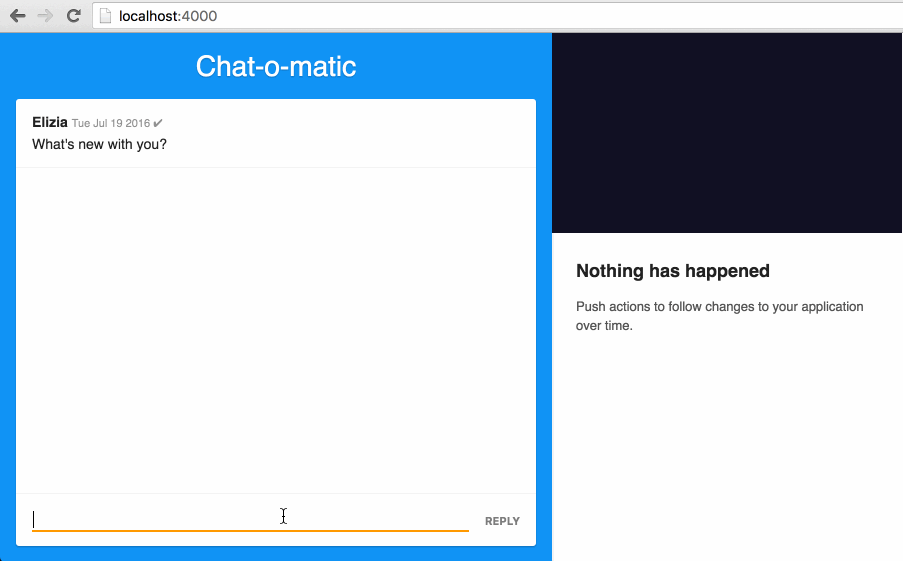Actions
Microcosm organizes itself around a history of user actions. As those actions move through a set lifecycle, Microcosm reconciles them in the order they were created.
Invoking push() appends to that history, and returns an Action object to represent it:
function getPlanet (id) {
// Fetch returns a Promise, handled out of the box
return fetch('/planets/' + id).then(response => response.json())
}
let action = repo.push(getPlanet, 'venus')
action.onDone(function (planet) {
console.log(planet.id) // venus
})Domains: Stateless Stores
A Domain is a collection of side-effect free operations for manipulating data. As actions update, Microcosm uses domains to determine how state should change. Old state comes in, new state comes out:
import { getPlanet } from './actions/planets'
const PlanetsDomain = {
getInitialState () {
return []
},
addPlanet (planets, record) {
return planets.concat(record)
},
register() {
return {
[getPlanet]: this.addPlanet
}
}
}
repo.addDomain('planets', PlanetsDomain)By implementing a register method, domains can subscribe to actions. Each action is assigned a unique string identifier. Action type constants are generated automatically.
Pending, failed, and cancelled requests
Microcosm makes it easy to handle pending, loading, cancelled, completed, and failed requests:
import { getPlanet } from '../actions/planets'
const PlanetsDomain = {
// ...handlers
register() {
return {
[getPlanet.open] : this.setPending,
[getPlanet.done] : this.addPlanet,
[getPlanet.error] : this.setError,
[getPlanet.loading] : this.setProgress,
[getPlanet.cancelled] : this.setCancelled
}
}
}open, loading, done, error and cancelled are action states. In our action creator, we can unlock a deeper level of control by returning a function:
import request from 'superagent'
function getPlanet (id) {
return function (action) {
action.open(id)
let request = request('/planets/' + id)
request.end(function (error, response) {
if (error) {
action.reject(error)
} else {
action.resolve(response.body)
}
})
// Cancellation!
action.onCancel(request.abort)
}
}First, the action becomes open. This state is useful when waiting for something to happen, such as loading. When the request finishes, if it fails, we reject the action, otherwise we resolve it.
Microcosm actions are cancellable. Invoking action.cancel() triggers a cancellation event:
import { getPlanet } from './actions/planets'
let action = repo.push(getPlanet, 'Pluto')
// Wait, Pluto isn't a planet!
action.cancel()When action.cancel() is called, the action will move into a cancelled state. If a domain doesn’t handle a given state no data operation will occur.
A historical account of everything that has happened
The source of truth in Microcosm is a historical tree of every action.
By default, this tree prunes itself as actions complete. However passing the maxHistory option into Microcosm allows for a compelling debugging story.
For example, the Time-Travelling Microcosm Debugger:
const forever = new Microcosm({ maxHistory: Infinity })
Networks of Microcosms with Presenters
A Presenter is a special React component that can build a view model for a given state, sending it to child “passive view” components.
All Microcosms sent into a Presenter are forked, placing them in a sandbox for data operations specific to their part of an application:
import Presenter from 'microcosm/addons/presenter'
import { getUsers } from '../actions/users'
class PaginatedUsers extends Presenter {
setup (repo, props) {
repo.add('users', PaginatedUsersDomain)
repo.push(getUsers, props.page)
}
model () {
return {
users : state => state.users
}
}
view ({ page, users }) {
return <UsersTable page={page} users={users} />
}
}
const repo = new Microcosm()
repo.addDomain('users', UsersDomain)
ReactDOM.render(<PaginatedUsers repo={repo} page="1" />, el)Why another Flux?
Good question! Other popular implementations of Flux treat actions as static events. The result of calling a dispatch method or resolving some sort of data structure like a Promise.
But what about everything before that point? A user might get tired of waiting for a file to upload, or dip into a subway tunnel and lose connectivity. They might want to retry an request, cancel it, or just see what’s happening.
The burden of this state often falls on data stores (Domains, in Microcosm) or a home-grown solution for tracking outstanding requests and binding them to related action data.
While manageable, we’ve found that this can be cumbersome. That it can lead to interface-specific requirements leaking into the data layer, resulting in complicated code, and unexpected bugs as requirements change.
How Microcosm is different
Microcosm thinks of actions as stories. They go through different states as they move from start to completion. Actions have a common public interface, regardless of what data structures or asynchronous patterns are utilized. An interface that is easy to query from the presentation layer in order to handle use-case specific display requirements.
This makes it easier to handle complicated behaviors such as optimistic updates, dialog windows, or long running processes.
Learn more
Get going with the quickstart tutorial, or dive deeper with our guide to architecture.